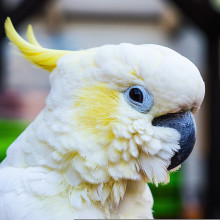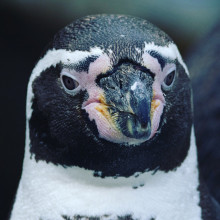Gene therapy saves baby from fatal condition
In the news this week, a UK toddler with a rare genetic disease is saved by gene therapy: we explain how it works. Cockatoos wow scientists by taking a toolkit along to solve a problem. And a 55 million year old penguin fossil… And it’s a whopper that weighed in at 150 kilos!
In this episode

00:58 - Life-saving gene therapy for UK baby
Life-saving gene therapy for UK baby
Rob Wynn, NHS
This week scientists announced that a toddler with a rare, fatal genetic condition has been treated successfully with a new gene therapy approach. 19-month old Teddi has MLD - metachromatic leucodystrophy. This is an inherited disease linked to a defective gene that normally codes for an essential enzyme called arylsulfatase A. Without this working, material builds up inside certain cell types and causes them to die. The developing brain is particularly vulnerable and affected individuals become progressively more disabled and usually don't make it past the age of 5. In Teddi's case, the Royal Manchester Children's Hospital's Rob Wynn and his colleagues have - they think - hopefully effected a cure. They've taken stem cells from her bone marrow and altered them in the lab to add back in a healthy copy of the gene, as well as some control information to supercharge its activity, leading to high level production of the missing enzyme. Those modified stem cells were returned to Teddi where they migrate to the bone marrow and produce blood and immune cells. Some of these then migrate into the nervous system where they pump out the enyzme for other cells to use…
Rob - In illnesses like MLD, where there is a deficient enzyme, we can use bone marrow transplantation to help the condition. And what happens there is the normal healthy bone marrow makes normal healthy blood, makes the enzyme and delivers that enzyme around all tissues of the body, including in the brain. We know when we do a bone marrow transplant in MLD, actually it doesn't correct the condition, and we've understood in recent years that's because normal healthy blood does not give enough enzyme in this condition. So we take blood stem cells from the patient and in the laboratory we insert the missing copy of the gene. Now we do that using a virus, but we have modified that virus. So when it infects their blood stem cell, instead of delivering virus DNA, they deliver the enzyme gene. But we've also made one other key difference. Genes in our cells are controlled in a very tight way. And actually the MLD gene is controlled in a very tight way in blood stem cells. And this is a why a normal bone marrow transplant does not give enough enzyme because the gene is turned off, the blood doesn't need to make a lot of enzyme. So when we use gene modified cells, not only have we put in a healthy copy of the gene, but we have changed the promoter next to that gene that tells the gene to be turned on. And so the gene modified stem cells make vastly more enzyme and because more enzyme is good for the disease then we actually see that this makes the illness better. Whereas a normal bone marrow transplant doesn't.
Chris - These are bone marrow stem cells, so they're going to be making elements of the blood and they're going to be outside the brain. There's a barrier in place that keeps the brain tissue and the blood tissue compartments separate, it's called the blood-brain barrier. So how does making the bloodstream awash with this missing enzyme get the brain treated?
Rob - This is an excellent question. It actually goes to the heart of why bone marrow transplant in cell therapy corrects neurologic enzyme deficiencies in a way that drug therapy does not. Cells can cross the blood-brain barrier and engraft, and wide cells becoming engrafted in the brain where they're known as microglia. So if we do a gene modified blood stem cell transplant, then we will get gene modified wide cells, they will cross the blood-brain barrier and then become engrafted in the brain. And so gene modified brain engrafted microglia make the enzyme that the patient needs and forever.
Chris - And when they're sitting in the brain, they're presumably secreting the missing enzyme into the milieu there and what the dependent cells that would normally be missing, it can pick it up and use it.
Rob - This is exactly the principle of transplantation in this type of disease and it's known as cross correction. The engrafted donor cells make and secrete enzyme. That enzyme is taken up by neighbouring cells that remain genetically enzyme deficient, but they're able to take up this secreted enzyme and metabolise within their cytoplasm accumulated substrate.
Chris - Is the prognosis then, for this young lady, a very good one in the sense that as long as she stably continues to have these cells making this stuff in her brain, then she should remain well?
Rob - We think that this girl can look forward to a normal life expectancy in a normal quality. So clearly using gene modified stem cells in MLD is new. However, we have a wealth of experience of using transplants from donors in similar diseases. And what we see in those illnesses is that the effect on the condition is lifelong. So we have every reason to be optimistic that the gene modified stem cells will also similarly dramatically change this young girl's life.
Chris - Are there any risks here? In the past, when people have used viruses to change stem cells in this way, they've been concerned that when you are adding bits of DNA to a cell's own DNA you can make cancers, and also if they are churning out huge amounts of this material that they wouldn't normally churn out into the bloodstream, are there any health risks from that?
Rob - Certainly all of our medical decisions are based on balance of risk. This is a disease associated with premature death and children are dying in early life and before dying they lose their skills that they had acquired. So risk balance is very much in favour of this treatment. Viruses insert their DNA into our DNA and this is why there is some cancer risk. If they insert their DNA next to what we call an oncogene that's associated with controlling cell proliferation, they can cause cancer. But the virus vector, as we call it here, is so modified that it inserts randomly into the genome, and if it inserts randomly then it's much less likely to cause cancer. In terms of the enzyme overexpression, that's a very important point. The very basis of this treatment is that the gene modified cells make much more enzyme in the blood. So in our preclinical work, we have been able to show that that enzyme expression, that enzyme overexpression as we call it, does not affect blood stem cell function. And so the cells are able to engraft and the cells are able to make blood that is otherwise normal.

07:59 - Cockatoos crack multi tool use
Cockatoos crack multi tool use
Antonio Mascaro, University of Vienna
And now to the animal kingdom and an equivalently clever cockatoo species. Goffin’s Cockatoos live in parts of Indonesia and they’ve been found to be capable of one of the most complex pieces of animal thinking ever encountered: they use tools to complete tasks; but not just one type of tool, several. And they can even plan ahead and take just the right number of different tools to get the job done. If only my builder could do that! Will Tingle takes up the story…
Will - Tool use, or using an external object to change something about another object, is very commonplace in our lives. Chopping food with a knife? That’s tool use. Driving a car is tool use, albeit a very complex tool. Tool use features in the animal kingdom too, but it’s a rare piece of cognitive behaviour, and has only been observed in 32 species so far. But even still there’s a step above tool use, which is tool sets. That is to say two or more tools with different functions being used together to achieve a single outcome. And that is even rarer still, as the University of Vienna’s Antonio Osuna Mascaro explains…
Antonio - There are only two species out there in the wild able to use tool sets or that are using tool sets out there. One is chimpanzees and the other is Goffin's cockatoos.
Will - The Goffin’s cockatoo is a parrot that lives in Indonesia and they are big fans of the stone inside a fruit of the ‘sea mango’ plant. But the fruit’s flesh itself is very toxic, and the cockatoos beak isn’t strong enough to open the stone. So what to do? Well, the cockatoos have been employing a form of tool manipulation that might put even the chimpanzees to shame.
Antonio - What the cockatoos did by surprise was to use three different kinds of tools to have access to this stone. The first one was the use of a tool with the function of a knife. They used this to cut in between both halves of the stone of this fruit after removing the flesh. Then they use a wedge to separate both halves slightly. And when they had this opening, they use a tool with the function of a spoon to be able to eat the insides of this stone. This is a pretty impressive kind of tool use and could be the most complex case of tool use out there in nature.
Will - So using a knife, a wedge, and a spoon to get to their food is impressive enough, but that's only a half of the cognitive conundrum. Do these cockatoos know which tools are needed for each step? And if so, would they only take the necessary amount of tools? If one of the steps was removed,
Antonio - We had five birds being tested and out of those five birds, four of them were able to transport eventually, and three of them were able to transport in a flexible way, even when this required flying with both tools. And that was amazing. That means that they were picking up and transporting both tools together every time that they were facing a problem that requires the use of both tools. And they were picking up both tools only sometimes when they were facing a problem that doesn't require both tools. So they were able to categorize both tools as a toolset. As we like to say, for them, a toolset is more than the sum of its parts.
Will - Goffin’s cockatoos then have the ability to not only understand which tools are necessary, but also which ones sometimes aren’t. So what is the reason for these cognitively confident cockatoos?
Antonio - Goffin's cockatoos are a very particular species. They learn to use tools in the same way as we do, and they learn by combining objects as toddlers do, by playing with different objects and combining them and then eventually finding functions and ways of using tools. We have 18 individuals in our lab and many of them know how to use tools, but it is interesting to see how each single individual uses tools in different ways. They have different techniques, different approaches. So each one of them have a different way of using tools and a different approach. And that is telling us that they're using their general cognitive capabilities to use tools. They're flexible enough that they can learn to use tools.
Will - The ability to use their claws and beaks to personally interact and combine tools allows them to form ideas as to which tools would work best, and in what order. This means they have a more complex knowledge of tool manipulation than any other animal besides us. Such behavioural complexity allows the Goffin’s Cockatoo to be outstanding in their field. Or, more likely their tree.

13:58 - Self-planting, drill shaped seeds
Self-planting, drill shaped seeds
Lining Yao, Carneige Mellon University
Seed carriers that can drill themselves into the ground to boost the success of sowing rates have been engineered by researchers in America. They've taken their inspiration from a grass species called erodium, which has a corkscrew-shaped seed with a sideways-pointing anchor tail at one end. When this lands on the ground, penetrating moisture swells the tissue, triggering the spiral to unfurl against the anchor, driving the seed into the soil. By working out how nature does this, Carnegie Mellon scientist Lining Yao has developed a way to copy and improve on the process using small pieces of wood that can be loaded with a seed cargo and then deployed as aerial seeding devices, for instance for regenerating tracts of woodland or conservation areas on a massive scale. Seeds that plant themselves in this way are much less likely to become mouse and bird food, or dried out by the sun...
Chris - And that's what you were seeking to make a replica or an equivalent of. Did you do it the same way?
Lining - On the material side, you need a stiff material. You need it to be biodegradable because we don't want to retrieve the seed carriers. We started to think about wood because it's a very abandoned, accessible biomaterial that are cellulose rich and also are known to have this moisture responsive behaviour. But we had to compare different kinds of wood. Eventually we chose white oak. We also have to think about the geometry. So one thing we did a little bit smarter than in nature is that we are introducing two extra tails. So basically the natural erodium only has a single tail. So when you drop it on the floor, it tends to land flat. But in order for it to drill, it has to lift its own body up by leveraging some crevices on the ground that limit the type of soil erodium can function in. So in our case, we introduced two extra tails. So when you drop our seed, they tend to land on the floor with a specific angle. And that angle helped improve the drilling efficiency.
Chris - How did you make these things. When one pictures this, the erodium seed, it looks almost like a little mini windmill with the seed at the bottom of a stalk. How did you make that, because you've effectively copied that with the three arms coming off of yours. How do you make it?
Lining - Basically it has two major steps. First, we need to process wood into veneers and then cook them in a chemical solution to make the wood more compliant. And the second step is we molded on top of a 3D printed mould that we tailored beforehand. Basically we have to wind it into the coil manually.
Chris - Got it. So you 3D printed the geometry you wanted, that you knew ought to work the right way, and then you mould the wood onto that. It's almost like forming it onto a mould to make it adopt that shape. And then you've got your seed carrier, but made of white oak.
Lining - Exactly.
Chris - How big is each one?
Lining - We make a range. So the smallest could be maybe one centimetre in height and you can make all the way about 10 to 15 centimetre in height. And again, this highly depends on what seeds or other things you want to carry with the carrier. Small vegetable seeds only need a very small carrier, but pine seeds, for example, are much larger. You need a larger body to carry them.
Chris - How did you test it to find out if it would really do what you were hoping it would?
Lining - We have done both in lab controlled tests and eventually we also brought it outdoor. So we've conducted five rounds of tests with hundreds of seeds in two geographic locations. We watched the weather broadcast right before heavy rain came. We threw them on the floor and then we monitored how effectively we can drill.
Chris - And what was the germination rate when you did this compared to if you just threw the seeds on the floor?
Lining - Across the five batches, we got about a 66% anchoring rate. And among the ones that anchored about a 60% germination rate.
Chris - And what about if you just threw seeds on the floor, the same sorts of seeds, how many of those would successfully germinate?
Lining - I really wanted to conduct this test, but we haven't got a chance to do this exact comparison. But we do know if you try to germinate pine seeds with broad casting from the aeroplane, the germination rate is 2 to 10%.

20:49 - Chinese balloon shot down over the US
Chinese balloon shot down over the US
The news over the past few weeks has been awash with stories of unidentified objects in US airspace, including one dubbed the ‘chinese spy balloon’. Recently, the two countries have had a tenuous relationship at the best of times, and this incident looks to add further strain. But how has the situation unfolded thus far?
James - I’m sure you’ll have heard, this week, of the Chinese surveillance balloon that the US shot down which they now claim was able to collect communications signals. Equipped with instruments capable of "intelligence collection operations", it has sparked a major international row.
Even more instances have been happening recently, as 2 other flying objects have been shot down over the US. These two have not had their origins confirmed yet, and have been described by US intelligence as ‘benign,’ much smaller in size, and not controllable from the ground. So only time will tell if their motives were nefarious or otherwise.
As for the main balloon, details remain scant but it is believed it took off from a base on Hainan Island along China's southern coast. It was spotted at 60,000 feet in Montana, before being shot down by a missile for violating US airspace. The Chinese government insists that the balloon was a ‘civilian airship used for research’, but American intelligence has since confirmed from that debris that the balloon was being used for surveillance. However, it is now uncertain as to whether the balloon was meant to enter US airspace, or was blown off course by strong winds. The balloon was tracked since its launch and made ‘unusual turns,’ first into Canadian airspace, and then down into US airspace. The wind could have played a part in its course, despite the US claiming that China had partial control of the balloon’s movements.
So if a balloon is so easy to spot and difficult to control, why use one in the first place? Well, a balloon’s movement pattern is harder to track than satellites, as they move more unpredictably, and are often smaller than a typical radar’s level of calibration. They can also hover above a certain point for much longer than a satellite. Satellites are tied to their gravitational orbit around the Earth, which is not helpful if you want to monitor the ongoing progress of something happening on the ground. Balloons can also sometimes dip under weather systems that would otherwise block a satellite's view of an area. And, in this balloon’s case, it can be used to listen in to devices. The balloon confirmed to have surveillance equipment attached had technology capable of locating communication devices and listening in to their conversations. But the conversations of who? Civilians? Governing bodies? That remains to be seen. The US is taking in all of the downed craft for extensive analysis.
There are, however, experts on the subject of surveillance intelligence who remain surprised as to why this individual balloon incident is gathering so much traction. Both countries already have extensively detailed maps of one another. There isn’t much a balloon could tell either side, but balloons have been a part of China’s surveillance division for some time now, and the US now has to revisit its policy on how finely it scans for foreign aerial objects, and how they will deal with them in future. All that can be said for certain is that it has been a diplomatic disaster for both countries.

24:19 - The biggest penguin fossil ever discovered
The biggest penguin fossil ever discovered
Daniel Field, University of Cambridge
The fossilised remains of one of the world’s largest and earliest penguins have been uncovered in New Zealand. Found in boulders on a beach near Otago in 2016, the remains, which date back over 50 million years, have now been carefully exposed so that the stature of the original animal can be appreciated and studied properly. It was a giant that would have weighed in at a hefty 150 kilograms. One of the team behind the discovery, and what it can tell us about the origins of penguins and their subsequent evolution, is Daniel Field, from the Department of Earth Sciences at Cambridge University.
Daniel - What we're talking about here with this giant penguin are the remains of its humerus or its upper arm bone and penguin humeri are very distinctive. Of course, penguin's move in a very different way from most other birds. They use their wings to fly underwater. And that specialized mode of locomotion has resulted in the evolution of a very distinctive humerus with an offset shoulder connection. The humerus itself is flattened, unlike a round cross section, like you see in the wings of flying birds. And so there's really no mistaking the humerus of a penguin when you find one
Chris - And you're extrapolating from what you do have to work out what what you don't have would've looked like.
Daniel - Yeah, so much of the humerus is preserved, not the entire thing, but I'm a pretty average size male in this country. I'm not quite six feet tall. But the humerus of this gigantic penguin would've been about the same length as mine. Just to give you a sense of how big this bone is.
Chris - You don't weigh 150 kilos looking at you <laugh>.
Daniel - I don't, I weigh almost exactly half that.
Chris - But this thing must have been enormous then.
Daniel - This was an utterly enormous bird. We estimate that it's body mass would've been in the range of about 150 kilograms, or I'm from Canada as you can probably tell from my accent. So back home we'd say 350 pounds, an absolutely huge, huge bird.
Chris -
Why so big?
Daniel - Well, there are various ideas about why penguins achieved such an enormous body size range early in their evolutionary history. Some of the most compelling ideas have to do with heat retention. Of course, birds and penguins are warm-blooded animals, and the larger you are, the deeper you can dive, the more oxygen you can hold onto. And these penguin fossils come from southern New Zealand. They would've been diving into very, very cold water. And being very large bodied would have enabled these gigantic early penguins to have collected more food, to have retained heat more efficiently, and probably also to have dived for longer because they would've been able to retain oxygen longer too.
Chris - But penguins still do all of those things today. So why have they shrunk?
Daniel - Well, penguins achieved very, very large body sizes early in their evolutionary history. So this fossil is about 57 million years old. And enormous penguins persist in the fossil record until around 30, 25 or so million years ago.
Chris - Oh, that's significant because the earth was really hot then. 30 million years ago, the polar ice caps melted, it was really warm then.
Daniel - That's right.
Chris - Was it a case they shrunk because the temperature went up?
Daniel - I don't think that's the argument I go with. There are smaller body penguins around at the same time. The important factor here is that around 30, 25 or so million years ago, marine mammals that fall within the same general size range as these very large body penguins came on the scene. And so we think the disappearance of these enormous penguins may have had something to do with the evolution of marine mammals that may have outcompeted these gigantic penguins.
Chris - So are you saying they're seal food?
Daniel - Well, they wouldn't necessarily have been seal food, but they might have been competing for the same food resources. And not only competing for the same food resources, but potentially also the same places at breeding colonies on beaches. Because of course, animals like seals need to come ashore to have their pups and penguins of course need to come ashore to lay their eggs.
Chris - You are saying this is 57 million years back in time. Now that is a significant point because that's not that long in geological terms after the dinosaurs disappear. So how significant is the timing that suddenly these very large birds are on the scene?
Daniel - So you're absolutely right, Chris. The extinction of the giant dinosaurs took place, we've got pretty good dates for this now, right around 66.02 million years ago. And the fact that we find these enormous penguins so early in the aftermath of this extinction event, within 10 million years of this extinction event, tells us that birds, once they lose the ability to fly, have the evolutionary capacity to attain enormous body sizes very, very rapidly. So it tells us something fascinating about the maximum possible rate of body size evolution in these animals.
Chris - And would it have been the disappearance of the dinosaurs that meant they could get that big because they weren't turning into dinosaur food?
Daniel - Ah, well it didn't have to do specifically with the disappearance of the dinosaurs, I don't think. But of course at the same time as the dinosaurs, we have giant marine reptiles that would've occupied these macro predatory marine niches. And I suspect it was the simultaneous disappearance of these giant marine reptiles 66 million years ago that may have opened up available ecological niche space that these birds would've been able to move into.
Chris - Is New Zealand special here?
Daniel - Well, New Zealand is very special when it comes to the fossil record of giant flightless birds because moa come from New Zealand as well as these giant penguins. But for penguin evolution specifically, New Zealand is very important because the very oldest penguin fossils we've ever found, as well as a very diverse fossil penguin fauna, have been recovered from New Zealand sediments.
Chris - Would this argue then that New Zealand is possibly the origin of penguins?
Daniel - Well, we think New Zealand and Australia would've separated around 86 million years ago. So New Zealand was an isolated land mass 57 million years ago when this giant fossil Kumimanu was alive. But the evidence that we do have suggests indeed that penguins may well have originated in New Zealand.










Comments
Add a comment